Is the World Ready for an LGBTQ Disney Princess (or Prince)?
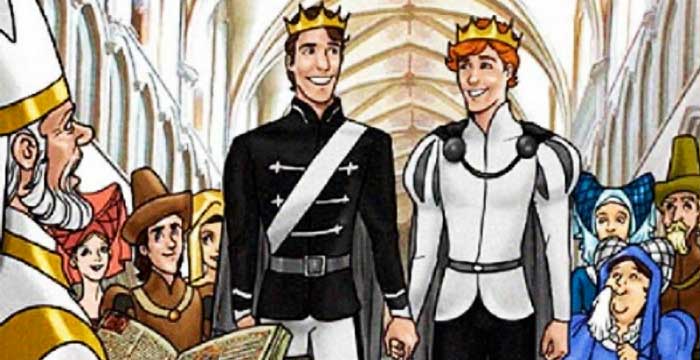
Well, is the world ready for a gay Disney princess or prince? In short: no. As I outlined in my previous article on Disney marketing, the Walt Disney Company is very focused on the majority of its demographic, which is heterosexual. While changing social tides have been reflected in changing representations of relationships in Disney films, it may be at least a decade or two before an explicitly gay character or relationship makes its way into the focus of a mainstream Disney “flagship” film.
However, this article will point out that while it may be a while before two princes or princesses “tie the knot”, Disney has already created many characters and relationships which can be read as queer. After all, “gay” only represents one letter in the LGBTQ spectrum. This article would like to focus on the “Q” group which can represent “cultural common ground between lesbians and gays as well as other nonstraights.” 1
This article will provide the reader with several tools and strategies for queer readings of Disney characters and relationships including how to look for things that are “queer coded,” how to read into “camp,” cases of queer authorship, references to LGBTQ history, and finally how to find empowerment from “queer homosocial” relationships and solidarity with other “transgressive” romances. After explaining a brief queer history of the Walt Disney Company, this article will apply these criteria to films made from the Disney Renaissance to the present. In this way, members and advocates of the LGBTQ community can claim, acknowledge, and celebrate the acceptance of queer voices in Disney culture in the present while looking positively towards the future.
What Is a “Queer Reading?”
In an academic sense, the word “queer” adheres to the idea, based on the theories of Judith Butler and Eve Kosofsky Sedgewick, that gender and sexuality are fluid constructions which can be assembled and disassembled in unlimited variations. In Sedgewick’s words, “Some people, homo-, hetero-, and bisexual, experience their sexuality as deeply embedded in a matrix of gender meaning and gender differentials. Others of each sexuality do not.” 2 A “queer reading” is a way of looking at something; it does not always imply that the creators intended for the character to be read that way or that a character is gay. To be queer is to fall outside the spectrum of what is considered “normal,” or as this article will say, “heteronormative,” with regard to gender and sexuality. Therefore, characters that are in male/female relationships can also be read as queer and queer readings can be done by people who are heterosexual.
Code, Camp, and The Importance of “BODY LANGUAGE”
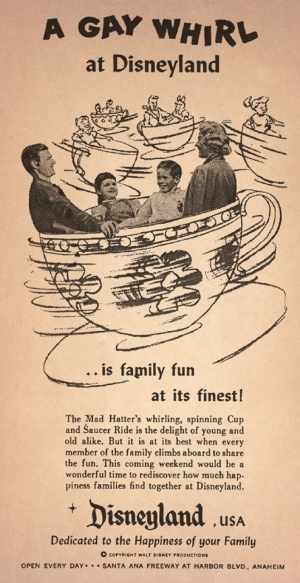
Many of the instances of queer readings during the Walt Era are defined by the closeted society in which Walt created his works from the 1920’s to the 1960’s. The Golden Age of Disney animation existed in the 1950’s when American culture was obsessed with maintaining “traditional” family values as a strong family was seen as the main line of defense against the “degenerate” culture of Communism. As Walt Disney, himself, created stories and characters which celebrated individualism and rebellion against authority Walt, was also a vehement anti-Communist, and much of his infamous social conservativism stems from these fears which much of his society shared. 3 Therefore, many of the films which define this era like Cinderella and Sleeping Beauty shamelessly promote heteronormativity and traditionalism. However, just as queer people existed in this time period, so too, do queer Disney characters. Because this was a time defined by the Closet, queer readings of Disney works from this time require the use of things like camp and code.
“Camp” is not something to look for; rather it is “a way of looking at things,” as Susan Sontag would argue. Many refer to something as “campy” if it is over-the-top, and much of Disney culture, being a culture of fantasy, is over-the-top. 4 Camp, therefore, as found in animation, brings attention to the fact that certain aspects of life, including gender and sexuality, are learned and performed. 5 This idea subverts the notion that heterosexuality is the natural default of human programming and points to the superficiality and fluidity of traditional gender specifications.

To say that something is “queer coded” is to say that a character exhibits cultural signs of being a member of the LGBTQ community. Over the years, the queer community has used its own internal code and society has used its own code of gay and lesbian stereotypes to defame LGBTQ individuals. To study the “queer coding” in the Walt Era is to study the later because of the Company’s fears of LGBTQ culture as a Cold War liability. Queer coded characters of this era are often villains such as Captain Hook or Shere Khan. Meanwhile campy villains such as Maleficent disrupt the heterosexual narrative of their respective films. However, members of the LGBTQ community have historically and recently used code and camp readings to claim and “reclaim” these characters as symbols of queer empowerment just as they have reclaimed the word “queer” which was once used as an insult.
Though the 1980’s large strides were made in accepting and incorporating members of the LGBTQ community into the Disney Company and culture. This policy was showcased in the fact that openly gay people like Producer and Lyricist Howard Ashman and animator Adreas Deja were hired and allowed to be open about their sexuality. In 1991, the Company instituted a non-discrimination policy and was one of the first Hollywood companies to offer same-sex partner benefits. 6 This queer authorship within the company brought about more camp and coded characters; only this time, the characters were being created from the inside of the community, out. This time, it was not about stereotypes but more about exploring the performance of gender and sexuality in American culture.
The biggest invitation for queer readings through camp is in the way Disney Villains perform and over-perform their gender “to the point where the ‘naturalness’ of their gender can be called into question.” 7 The design for Ursula, for example, was based on the famous drag queen Divine. Ursula, with her over-the-top performance of femininity, and connection to drag draws attention to the performative nature of gender and sexuality, especially in her famous line “Don’t underestimate the importance of body language!” In her drag-cabaret-like style song “Poor Unfortunate Souls,” she teaches Ariel how to perform her gender and sexuality through what Judith Butler would call a “stylized repetition of acts.” 8 Ursula, in the meantime, has become a drag queen favorite and a symbol of lesbian empowerment.

One might naturally, however, show concern over the fact that queer coded characters such as Ursula, Jafar, Scar, and Governor Radcliffe are portrayed as villains. In response to these concerns, I would like to point out two things. First, that Disney culture is one of the few cultures in this country which celebrates and even reveres its villains. Disney opened a Villain’s Store in MGM studios in the early 1990’s which shows that campy villains are not just embraced by the LGBTQ community but by much of mainstream America as well. Recently, movies such as Maleficent have reclaimed villains from their one-dimensional beginnings as a larger sign of the times which insist on more nuanced representations of LGBTQ individuals. Also, there are other queer coded Disney characters from the Walt Era to the Present which are not Villains. They include the Reluctant Dragon, the Mad Hatter, and many others as the next part will reveal.
Queer Readings of Disney Films (1989-2015)
The next part of this article will apply the criteria for queer readings to Disney texts. These readings include other strategies such as queer homosocial relationships and a look into queer authorship and reception. These are not all of the films Disney has made: for the sake of length I am limiting this analysis to the films from The Little Mermaid to Frozen which have the strongest cases for queer readings. I encourage the reader to take these methods and apply them further (feel free to leave them in the comments section); not just to Disney texts but other works in pop culture as well which have been traditionally seen as exclusively heterosexual.
Part of Your World: The Little Mermaid
Code/Camp Characters: Ursula
Queer Authorship: Howard Ashman (lyricist) and Andreas Deja (lead animator on King Triton who is one of the first Disney male characters to be drawn with any kind of sex appeal). Also Hans Christian Anderson, who is believed to have been gay, wrote the original source material. 9
Transgressive Sexuality: Ariel is in love with a human being. This kind of relationship can be read as queer, because of the unnaturalness of an inter-species relationship but also because it is looked down upon in Ariel’s society. The scene between Ariel and Triton, in particular, where he shouts “He’s a human, you’re a mermaid!” and Ariel responds, “Daddy, I love him!” can be read as her “coming out” to her father.
Queer Themes: Aside from the controversial nature of Ariel and Eric’s relationship and an emphasis on the performance of gender and sexuality, another queer theme is one of straight privilege. Often one might criticize the film for the way Ariel begins as princess of the entire ocean and still, somehow, seems dissatisfied. One might also criticize the way that Ariel gives up everything for her man. These actions, however, potentially speak to the gay community (especially the white, middle class gay community) who must sacrifice a part of their privilege to follow their love and often sacrifice much more, including one’s “voice.” The song “Part of Your World” also speaks to Ariel’s status as “outsider” within her world.
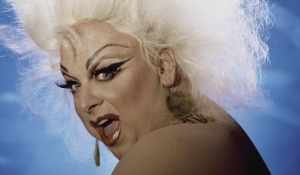
LGBTQ History: As mentioned earlier, Ursula is based on the drag queen Divine but also sings her song in the style of cabaret: a European performance style heavily associated with the Weimar Era before and during the rise of Hitler. Cabaret, as a performance style, is associated heavily with Jewish culture and queer culture and was heavily suppressed by the Nazis as many performers were killed for their “degenerate” art style. The musicality of the song “Poor Unfortunate Souls” is derived from this style with similarities to the songs “Wilkomen” (Cabaret) and “Mack the Knife” (The Threepenny Opera). 10 Ursula’s use of a music style which is connected to Jewish and queer resistance in the face of oppressive conformity not only speaks to Ursula’s status as “outsider,” but her status as “rebel.” Both Ariel and Ursula are connected in their rebellion against Triton, though they take different approaches for different reasons.
Queer Response: As mentioned above, Ursula has been claimed as an LGBTQ icon and the phrase “Part of Your World” has been used as a slogan in favor of gay acceptance. 11
A Beauty But A Funny Girl: Beauty and the Beast
Code/Camp Characters: Cogsworth, while male is coded as feminine or queer. This is present in several lines such as “I know it’s a girl” (which implies that he is less familiar with women than men) and “flowers, chocolates,… promises you don’t intend to keep” (which implies that he has experience with men breaking his heart). He is also single. Lumiere on the other hand is arguably bisexual or pansexual based on how much he enjoys kissing Cogsworth.
Queer Authorship: Howard Ashman (producer and lyricist) and Adreas Deja (lead animator for Gaston who Deja has said he based on hyper-masculine gay men in the urban gym culture of the 1980s). 12 David Ogden Stiers (the voice of Cogsworth), while closeted at the time of Beauty and the Beast, came out as gay years later.
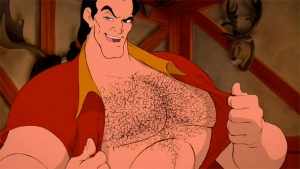
Transgressive Sexuality: Again, Belle and the Beast’s relationship is unnatural because of the human/non-human dichotomy. This taboo relationship causes an uprising within the village.
Queer Themes: Again, there are themes of Otherness as both Belle and the Beast seem to fall in love because of their respective attractions to their shared experiences as “outsider.” Also, Belle is labeled as a “funny girl,” because she does not share the same attraction to Gaston as the other women do. “Funny” is often another word for “queer” as it seems the town questions her sexuality based on the fact that she does not respond to the binary differences between her and Gaston. There is also no “love at first sight” between Belle and the Beast which subverts their heteronormativity.
Homosocial Relationships: The relationship between Cogsworth and Lumiere is complicated but is one of the most compelling relationships in the film. It is clear that these two men gather empowerment from each other. In Lumiere’s case, his relationship to Cogsworth seems more meaningful than his relationship to Babette.
Same-sex Pairings: Another strategy for a queer reading is to look at same sex doubles (or in the case of the Bimbette’s a trio). This emphasis on “sameness” can be read as queer even if there is not sexual relationship between these women. Also the comparing of the Beast and Gaston places the two men in same-sex juxtaposition.
LGBTQ History: In 1966, a violent police raid on the gay bar Stonewall resulted in the gay people fighting back. This is seen as the beginning of the Gay Rights Movement in America. During the “Mob Song” a violent attack of the “enchanted castle” results in the objects fighting back. This act of self defense among “freaks” against the “normal” population invites links to Stonewall.
Queer Response: Metaphors have been drawn between the Beast’s curse and Howard Ashman’s battle with the AIDS virus which claimed his life before the picture was completed. The most prominent of this kind of reading came from heterosexual reporter Dan Rather in 1991 proving that queer readings are possible from non-queer individuals. 13
Shopping For Curtains: Aladdin
Code/Camp Characters: Jafar and the Genie. The Genie’s many personas speaks to the fluidity of gender and sexuality as he is often “in drag” or playing a queer coded fashion consultant.
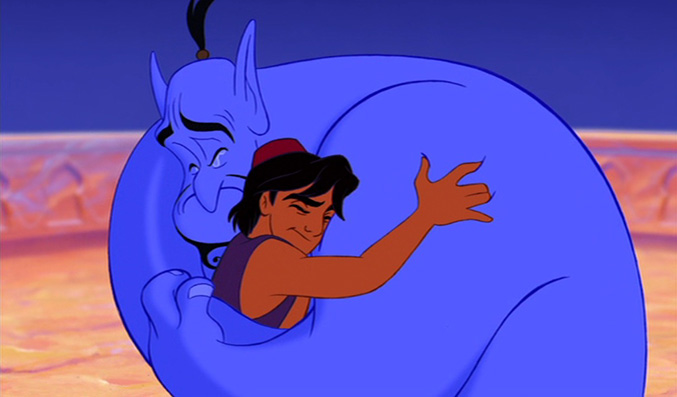
Homosocial Relationships: While Jafar and Iago’s relationship is homosocial, the most compelling relationship in the film (arguably more interesting than the one between Aladdin and Jasmine) is the relationship between Aladdin and the Genie. There is even a reference to “picking out curtains” which opens the door to a gay reading of their relationship. Aladdin has several compelling homosocial relationships in the film including the monkey Abu and the Carpet.
Queer Authorship: Howard Ashman (producer and lyricist) worked on this film before he died and animator Andreas Deja was the lead animator on Jafar.
Queer Themes: In this case, Aladdin wants to break out of the essentialism which defines him as just a street rat singing “There’s so much more to me.” Also the Genie wants to be “set free” which can be an allusion to “the closet.” Ultimately it is the love between Aladdin and Genie which sets him free: an “act of true love” which can be likened, in true Disney fashion, to the power of “true love’s kiss.”
LGBTQ History: The Middle East in Western imagination has been historically seen as an exotic wonderland for alternative sexuality. These ideas go back to the Crusade Era when European propaganda stated that the Muslims of the East engaged in all sorts of “barbaric” sexual acts including homosexuality. These ideas motivated LGBTQ individuals in Europe to travel to more exotic locations during the Imperialist days of the British Empire (think Lawrence of Arabia) and these sentiments are also present in modern movies like 300 and Alexander which show the East as being much more sexually indulgent. Thus, the world of Aladdin invites the queer reader to indulge in a world where gender and sexuality are as vast and mysterious as the Arabian nights.
Queer Response: This was the first Disney animated film to specifically market to gay audiences in a commercial featuring the Genie as the queer coded fashion consultant. 14 Special screenings of Aladdin were used to benefit the fight against AIDS. 15
There’s One In Every Family: The Lion King
Code/Camp Characters: Scar, Zazu, and Timon are all men with feminine mannerisms.
Queer Authorship: Openly gay Elton John did the music for this film while Nathan Lane provided the voice of Timon.

Homosocial Relationships: Timon and Pumba are the obvious answer to this one, especially in the way that they are threatened by Nala’s entering Simba’s life. The relationship between Simba and Mufasa is at the heart of the film. While they are father and son, the empowerment that Simba draws from his father outweighs his relationship to Nala.
He Came So Highly Recommended: Pocahontas
Code/Camp Characters: Radcliffe, Percy, and Wiggins (who’s first instinct to deal with the Native Americans is to give them gift baskets).
Queer Authorship: David Ogden Stiers provided the voice of Radcliffe and Wiggins. The fact that this gay actor provided the voice for the two queer coded characters lends attributes of same sex “doubles” as well because their voice comes from the same man.
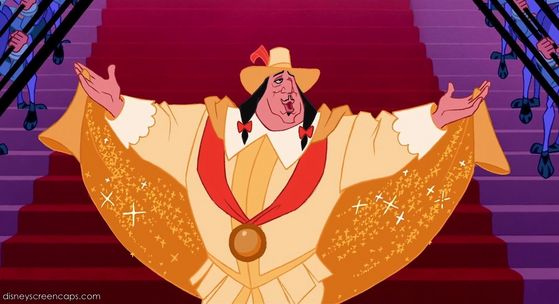
Homosocial Relationships: The relationship between Radcliffe and Wiggins is interesting as there are several implications that they are involved with one another. First the film establishes that Radcliffe is possibly gay by mentioning the “gossip” in the royal court about him. Then there is Radcliffe’s mention that Wiggins was “highly recommended” which can be read several ways along with Wiggins line “I like you!” The more compelling homosocial relationships in the movie, however, are between Pocahontas and Grandmother Willow and Pocahontas and her best friend Nakoma who, while she admits she thinks Kocoum is soooo handsome, shows an awful lot of jealousy over Pocahontas and John Smith’s relationship.
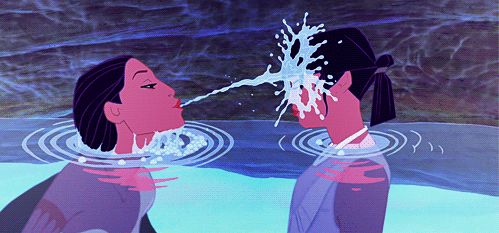
LGBTQ History: King James I of England, referenced several times in this film, was notoriously gay. Radcliffe’s comment about his “dear friend King Jimmy” implies through its casualness that Radcliffe and King James play for the same team. A possible analysis of Radcliffe’s evil is the fact that as a queer individual he cannot participate in the catharsis of Pocahontas and John Smith’s union as the rest of the cast can. This is apparent after Pocahontas saves John Smith and the two societies collectively put down their weapons. King James’ appearance in Pocahontas II: Journey to a New World makes him an official gay character in a Disney film.
Out There: The Hunchback of Notre Dame
Homosocial Relationships: The relationship between Hugo and the goat, Djali, is considered to be Disney’s first openly gay couple.
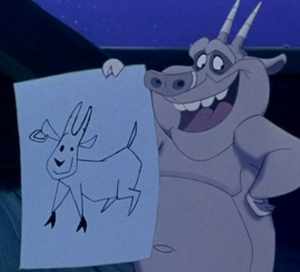
Transgressive Sexuality: In this scenario, Esmeralda’s explicit sexuality is seen as sinful and she is persecuted for this. Meanwhile judge Frollo wrestles with his sexual attraction to Esmeralda in the same way that many queer people might wrestle with theirs.
Queer Themes: Quasimoto’s situation can be likened to being “in the closet” as personified by his song “Out There.” There is also a theme of social justice in Esmeralda’s “God Help the Outcasts” which can be read to include the queer community.
LGBTQ History: This film was released around the same time that fundamentalist Christian groups were boycotting the Walt Disney Company because of their endorsement of homosexuality.
A Girl Worth Fighting For: Mulan
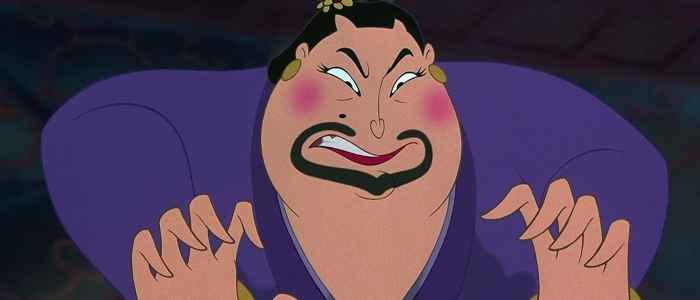
Code/Camp Characters: The Matchmaker, while a woman, acts more like a man in drag. The three soldiers Yao, Ling, and Chien-Po can be considered queer coded because of their over-exaggerated masculine performance or feminine tendencies.
Queer Authorship: Openly gay Harvey Fierstein voiced the role of Yao who asks if a dress makes him look fat.
Queer Themes: Mulan sings in the song “Reflection” about how if she were to be herself, she would break her family’s heart. Then there is the obvious fact that she cross dresses as a true expression of herself and proclaims that she never wants to see a naked man again. Also there is the fact that Captain Shang starts to have feelings for Mulan, under the impression that she is a man.
Change Your Fate: Brave
Homosocial Relationships: One of the most impactful aspects of the film is that the end features two women riding off into the sunset. Yes they are mother and daughter but it is a relationship between two women none-the-less. Perhaps Disney is preparing audiences for seeing this.
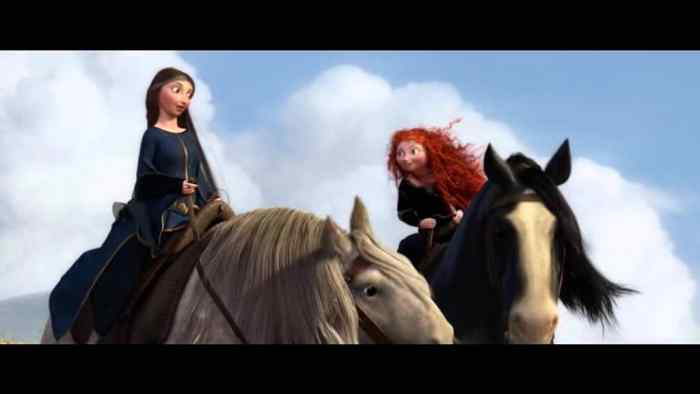
Transgressive Sexuality: Merida’s refusal to marry any of her suitors causes many to question her sexuality. While she never mentions attraction to the same sex, her rejection of heteronormativity queers her character to the point where she accused of lesbianism.
Let It Go: Frozen
Homosocial Relationships: The relationship between Elsa and Anna is central to the film. Ultimately this is a film about two women and the empowerment they receive from each other. While they are sisters, the liberating “act of true love” is one between two women. The relationship between Kristoff and Sven and Sven and Olaf is also important. Sven and Olaf, like Hugo and the goat are considered to be another Disney gay couple.

Queer Authorship: Openly gay actor Jonathan Groff voiced Kristoff while actors like Idina Menzel and Josh Gad (while both straight) have been associated with queer-themed musicals such as Rent, Wicked and Book of Mormon. Like The Little Mermaid, the allegedly gay Hans Christian Anderson wrote the original source material. Like the film Maleficent this version reads deeper into the character Elsa who was originally supposed to be the villain.
Queer Themes: Again the themes of being an “outsider” or “in the closet” are prevalent. Elsa is “cursed” with an ailment from birth (she was born that way). She is told to “conceal, don’t feel, don’t let it show.” She ultimately locks herself in her room (a closet) for fear of hurting her loved ones. After revealing her power she is persecuted and sings “Let It Go” as her coming out anthem. However, she soon realizes that “coming out” isn’t as glamorous as she’d hoped. Meanwhile it is only through the love and patience of her family that she is able to abandon fear and embrace her power. There is also Oaken and his “family” which implies that he is gay.
Queer Response: “Let It Go” has become an LGBTQ anthem. There has also been a huge response to the queer themes in this movie.
Give The Mermaid Her Voice
In conclusion, the reader may notice some threads in this long list. First, that as the years go on, the criteria for queer readings of Disney films gets shorter and shorter. One may also notice that the films with the most queer criteria are also the most popular. While many of these themes and attributes may lie beneath the surface for mainstream audiences, one could argue that a Disney film is more popular when it has more queer characters and themes. The more people address these themes, the more mainstream they will be Disney is likely to pick up on the popularity of LGBTQ characters. The sooner this happens, the sooner the world can expect a more openly LGBTQ relationship on the Disney screen.
Works Cited
- Doty, Alexander. Making Things Perfectly Queer: Interpreting Mass Culture. Minneapolis: University of Minnesota Press, 1993., pg. 2-3 ↩
- Sedgewick, Eve Kosofsky. The Epistemology of the Closet. Berkley: University of California Press, 1990., pg. 26. ↩
- See: the book From Walt to Woodstock for more a more detailed analysis of Walt’s politics. While his father was a staunch Marxist, and Walt was raised in a Marxist household, much of Walt’s political identity centers around anti-authoritarianism which is a theme present in much of his work. Walt was a staunch anti-Fascist as well and valued individualism. Despite his conservative stance on certain things, his focus on individualism opens the door for queer readings because of the individualized nuances of queer theory. ↩
- Griffin, Sean. Tinker Belles and Evil Queens: The Walt Disney Company from the Inside Out. New York, London: New York University Press. 2000. pg 68 ↩
- Griffin, 69 ↩
- Griffin, 107 ↩
- Griffin, 73 ↩
- Butler, 402 ↩
- Griffin, 144 ↩
- For more information on the queer roots in cabaret, see the BBC documentary “The Real Cabaret.” For more information on the Jewish music roots of musical theatre see the PBS documentary “Broadway: A Jewish Legacy” keeping in mind that the composers of The Little Mermaid (Alan Menken and Howard Ashman) were both Jewish. ↩
- Nichols, James Michael. “Chris Villain Releases ‘Part of Your World’ (VIDEO).” Huffington Post. April 8th, 2014. Web. Nov. 23, 2015. ↩
- Griffin, 142 ↩
- Rather, Dan. “The AIDS Metaphor in Beauty and the Beast.” Los Angeles Times, Mar. 22, 1992. Web. Nov. 2014. ↩
- Griffin, 190 ↩
- Griffin, 103 ↩
What do you think? Leave a comment.
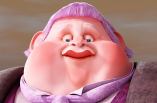

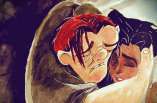








I actually had an idea of a gay-version of Cinderella. I even try to write this story now.
As incredible as that sounds, the last thing Hollywood needs is another adaptation of Cinderella.
I don’t want a gay/lesbian Disney film… I’m probably the only gay guy whose ever said that.
Probably lol
I think that the gay Prince should act like a regular guy you know, back when there were princes and stuff. He should be really cool, and people should have respected him. But when he was fifeteen, people in the kingdom found out he was gay, so after being bullied a bit he ran away. He has been homeless since and now age 25 finds his way into a kingdom where their prince is opnely gay (and really hot) Prince Outcast #1 wants a piece of that rainbow cheesecake and goes for it. And is surprised when the hot gay prince that he wants actually wants him back. Princely fluffy cute stuff occurs before Prince Outcast #1 discovers that his kingdom was taken over after he ran away by an evil tyrant. So him with his new prince boyfriend go back to try and win back the kingdom. They succeed and get married and unite the two previously enemy kingdoms and all live happily ever after. The end.
The story should be about a prince that is being forced to marry a princess to save his kingdom but he is not sure about his feeling cuz he has feelings for his best friend the stable boy, the villain should be the king of the other kingdom who wants his daughter to marry the prince, the prince, the princess and the stable boy go on a journey of selfdiscovery where they realize that they need to love themselves and accept everyone else as they are and at the end the princess tells her father that she will marry a prince from a different kingdom the prince confesses his love for the stable boy and the stable boy reciprocates.
Disney is suppose to target just straight relationships where a princess marries a prince. They want to make little girls feel like they want to marry some sort of heroic prince or any prince of some sort. Or make the characters more independent. It’s more inspirational than seeing two men or women have a simple story getting married.
I would be happy if Disney did a openly gay movie it would probably help people accept gay couples
Disney is the same damn thing every time, damsel in distress is in trouble, hero saves her and they live happily ever after. Always the same plot! Not that I don’t like the movies but sometimes it’s just annoying.
I think thatvif this article proves anything it is the complexities and diversities which exist in the seemingly unitary plots.
The contra to this is that this is a theme that has been expressed from time immemorial. This would be familiar to the people of the Medieval era.
Disney has toyed with gaynimation here and there.
Feminism has found a slight toe-hold in Disney films lately.
i think people who think that a gay Disney film wont work are narrow minded, at the end of the day teaching children it is okay to be different and love comes in all shapes, sizes and genders in my eyes is a good thing. This is why people these days think its wrong to be gay, lesbian and transgender because the world is constantly drumming into their heads man and woman. I think its time for change and here’s a perfect reason.
kys
TBH people would go crazy if Disney made a gay movie..
This is a great article! It would be great for Disney to have an openly gay prince or princess, but I agree that they’re not ready yet.
I have always said Disney is Homophobic except for 1 day a year when Disney has gay days. But Disney makes kids and family movies and are afraid of the “million homophobic moms”. But can you imagine the positive message it would send for those gay kids that have to deal with all the shit is someone like Disney took a stand and said its ok to love yourself and be yourself.
Well, as much as I agree that it would do a world of good for the gay community if there was a gay Disney prince or princess, the article clearly outlines the ways in which the Walt Disney Company has been inclusive (and was one of the first studios in Hollywood to do so) and has had to face a lot of criticism from conservative groups because of this stance. Disney HAS taken a stand several times.
FYI, in 1992, there were LGBT protesters outside the Academy Awards protesting the Film Silence of the Lambs and its portrayal of an LGBTQ character as a murderer. This is the same Academy Awards where Howard Ashman’s partner accepted his posthumous Oscar for Beauty and the Beast after Ashman died of AIDS. Disney was well ahead of its time for a long time.
I imagine Prince Hans as gay: good looking guy pretends to like the girls…
Jack Nicholson for the Voice of the sugar daddy.
I’d love for Link from the Legend of Zelda video game series to finally go on a never ending quest to find his boyfriend.
If I ever get into a studio like disney or such I totally would stand up for making a movie with a homosexual couple!
Disney should make an animation of Shakespeare’s romeo and Juliet but have them as two princes…with a happier ending! Or the count of Monte cristo gay edition but updated with the count forsaking his revenge for true love with a gay guy!
The biggest problem with a gay prince Disney movie is. Well first let me get it straight I would want one and this isnt meant to be homophobic. But there are obviously other countries that wouldnt allow showing a gay movie of any kind, nonetheless Disney because kids watch it. It would kinda mess with Disney if they had a couple countries who would refuse to show their movies for a while just because of something as simple as gay princes.
Agreed. Disney is a pretty liberal and accepting company, and the only thing holding them back is the rest of the world.
I wish they made Cinderella a lesbian in the new movie. That would have been amazing!
C’mon Disney get with it.
Well, I *think that most Disney movies are traditionally based on The Brothers Grim stories, which are full of straight people. Medieval culture liked to burn gay people at the stake, along with witches. So I’m not convinced that Disney has a lot of libretti to work from on that score. On the other hand they did Mulan about a girl dressed as a guy, but instead of that turning into a lesbian story, she goes for the guy in the end, so . . . . Let’s face it. Disney is the ultimate purveyor of the straight agenda. *shrug. Watchya gonna do?
Its interesting that cross-dressing is so heavily associated with lesbianism. One does not have to cross-dress to be a lesbian and not all lesbians are masculine. I hope that if this article has communicated anything it is that Disney is not NEARLY as heteronormative as people believe.
Hopefully Disney will have a gay prince! Before I even knew what being gay meant, I had a thing for Aladdin.
My favorite Disney Prince Is Aladdin!
Knowing Disney, it will probably take like 500000000 years before they come out with one. Frozen has been in the making for as long as Disney existed literally, a 12 year gap between Finding Nemo and it;s sequel, are u fucken kidding me.
Read “King and King”. Not fake, I promise this is a real published fairy tale about gay princes who fall in love with each other. Look it up! There. Disney can copy books like they usually do!
they should make a movie that its a bisexual prince but he falls in love with a girl. However the kingdom thinks because hes bisexual hes just gay so they keep arranging him with other guys. (really the moral is bisexuals can be in straight relationships too thats the point)
it wont happen in the next 1098764 years… and the princes in disney movies are only there bc of the main character :: THE PRINCESS … so a lesbian princess is gona happen first.. (i guess)
My own prediction is that because Princes have more leeway (because they are not as idolized as the Princesses) it would happen with Princes first but it would be a short film or cartoon attached to a larger one. We’ll see.
It’s SO FRUSTRATING that there hasn’t been a kids movie (let alone a disney movie) with a prominent queer character. A supporting character in Paranorman is literally the ONLY representation out there right now.
I don’t feel like they should make a movie like that I’m probably going to get a lot of hate
No hate here. I would be interested in hearing your thoughts on the matter.
You should look up “Shounen Ai Fairytales” its an adorable webcomic about a BUNCH of different farytales. All gay, and its the cutest thing ever. (you may have to look up a few japanese vocabulary words but its so cute) Also theres a gay webcomic of the Little Mermaid somewhere on the internet.
The only way for kids to truly understand that homosexuality is normal is for them to see it at a young age through something like disney movies. Imagine a world where no one even questions homosexuality and its just a part of life. yeah, some guys like guys and some girls like girls — big deal! it doesnt hurt you!
Disney very rarely sets its films in modern times, modern norms about gender equality have worked their way in. Gay norms, not so much.
I need it! I need my gay disney prince >.< I need my gay disney princesses too.
It should be a reverse romeo and juliet story where the parents of two families wants one families son to marry the other’s daughter but it turns out the sun falls in love with his wife to be’s brother. Disney make it happen.
Also, no gay super heroes? C’monnnn~ Captain America and Bucky have totes been doin’ it since 1940 and then Batman and Robin? Helloooo I betcha even Hawkeye be gettin’ some man action cuz Natasha be totally into that. Of course there’s also The Hulkling and Wiccan. Spiderman is bisexual too, right? All the superheroes love the D. I mean, no one can prove otherwise.
Please make a romantic fairy tale starring gay characters.
Great article, and excellent research on the subject material. When I started reading, I was afraid that it was going to go in a rather negative direction, but I positively agree with what you’re saying here. i don’t believe that the company is ready to make anything that specifically revolves around an LGBTQ subject. I do believe, however, that they are at a point where they can begin to introduce explicitly queer characters into their films; they should slowly begin to introduce characters who are /actually/ LGBTQ into the films, at least as background characters, instead of allowing them to just be queer-read into the film.
Well if more people claim these characters as queer it will send a large message, creating a new voice for the LGBTQ community and their advocates. I would predict that if Disney were to feature a gay story-line, it would be in one of its short films first.
I love Ursula, she is so fierce! I will be so happy when Disney gets progressive enough to have proper LGBTQ representation. We cant live on fanfiction and theories alone!
What a gay Disney movie would do is make gay kids and kids of gay families feel accepted for who they are, and it would teach other kids to be more accepting.
I had a idea of a gay Disney movie it’s a mixture of the little Mermaid and beauty and the beast, it’s a merman meets a beast and they fall in love
Great crash course on queer readings in relation to Disney films!
I’ve so been talking about a gay Disney princess movie! And honestly, I already have a good plot for it, so if Disney doesn’t want it, I’m writing it anyways.
I happened to start reading this as my sister put on Aladdin, and I so enjoyed your queer analysis of it! This whole piece was well-written and kept me on the edge of my seat for what movie you were going to do next. (Hint: I want more!)
Thank you! I’m really glad you enjoyed it. I would be happy to queer-read any Disney film not listed here. Also, if this topic interests you, I recommend reading the Griffin book in the Works Cited. He mostly does gay male centered readings but those can be the basis for other readings!
Thank you for that recommendation. I’ve written down Griffin’s name and the book and it is at the top of my list to look into! I’ve read Sedgwick and Butler before and really admire their work and way of thinking, so I am sure I will enjoy Griffin’s work!
If you’re interested in more on the methodology I also recommend Stacy Wolf’s book Changed for Good: A Feminist History of the Broadway Musical. Since a lot of Disney films are musicals, it helps too. She’s pretty brilliant and reads from a more generally queer perspective, although she primarily reads from a lesbian perspective. (in case you get bored with Griffin’s male reading lol).
I’m glad to learn that the Walt Disney Company has long had gay-friendly corporate policies. And I know that at least a few of these characters (especially Ursula) have been reclaimed as queer icons, so to speak.
But I worry that this article lets Disney off the hook for its heteronormativity. At the end of the day, all of the romances in Disney films occur between a boy and a girl. And while some characters do occasionally transgress gender norms, none of them comes close to actually identifying as trans or genderqueer or what have you.
Which is fine, I guess, but this feels like giving credit to Disney films for being secretly “queer coded” despite the fact that there is literally no explicit indication that Disney character thus far has been even the slightest bit queer.
Well-researched article though.
Thank you for your feedback. With regards to letting Disney “off the hook” I would argue that first of all, the Walt Disney Company is an old company with a long history. If one holds that history next to the history of LGBTQ rights and acceptance in American culture, one sees that Disney is often ahead of its time since Eisner took over. Even though the Gay Rights movement has culminated in the recognition of gay marriage, for instance, the Closet is still a harsh reality for many in our culture. One might argue, as I often to, that the Disney Company, itself, is “in the Closet.” Sure there are male/female relationships and romances but one must ask himself “Do we buy it?” I think this article says, “No, I don’t buy it; something else is going on here.” “Hetero,” maybe. “Normative,” definitely not.
Meanwhile, we wait for the next step. Thanks again!
Thanks, Christen, for such an eye-opening and research-filled article! I’ve often heard off-hand references to Disney queer-coding without the sort of lay-it-out analysis you have here. The explanation of what’s “code” and “camp” is especially helpful. This article really shows me much of the positive side of Disney’s queer-coding. This is very relevant to larger discussions of representation vs. subtext, for which I’ll just say that jokes and winks are at best not enough and at worst damaging.
As for the rhetorical conceit of your article, Is the World Ready? I don’t feel authorized to guess. My question is more, Is Disney ready? I think a lot of their audience would trust them if they sold it right. It’s also quite possible that one of their live-action retellings could star a queer character before an animated story does, in the vein of Maleficent (I see the queer-coded signals all over that). I also believe the advancement of female relationships is a preparation for a princess who likes women. If Frozen had been about two unrelated women, and “Let It Go” ‘s sexual-awakening hints clearer, it could easily be this movie we dream of. As we move towards the day, it’s great to get a look back on Disney’s queer history.
Thank you for your comment. I am glad that I can provide some context to the many sites out there which talk about “queer coded” Disney.
This was a really interesting article, and I agree that we will probably not see an openly gay Disney character for a while. I love your mention of The Little Mermaid and that Ursula was based on Divine. Also, as you mentioned, Howard Ashman was openly gay during his tenure with Disney. He is even thanked during the end credits of Beauty and the Beast (after production he had died), for giving “a mermaid her voice…” Tears. The Little Mermaid will always have a special place in my heart.
I think it’s also important to highlight the question of whether or not current societies are ready to show their children an openly queer couple coming from such an influential source. I don’t think there is enough education about queerness in many areas and many children wouldn’t understand a queer Disney main character like we would want them to.
Disney Pictures has hardly been a pro-gay propagandist. While it’s true that the Disney corporation has long supported its lesbian, gay, bisexual, and transgender employees, and hosted “Gay Days” at its theme parks. But when it comes to its most influential products, Disney merely perpetuates the heteronormative status quo.
I would agree that they are not pro-gay propaganda; however I strongly disagree that they perpetuate heteronormativity. Don’t forget that it’s not just “gay” and “straight.” There is a whole spectrum in between. While it’s true that there have not been any gay major characters or relationships, that does not mean that the plots of Disney films are “heteronormative” just because they feature male/female relationships. Disney products are “hetero” but as this articles showcases, they are definitely not “normative” and therein lies their redemption.
I personally don’t think society is ready for LGBTQ. I think it’s too soon considering it ironic because our technology has sped up but not our acceptance towards things like openness to LGBTQ.
I think that it has been made clear that the masses can accept implicit LGBTQ+ ideas in their Disney films, but it will be decades before we see an explicitly queer plot or main character from Disney. This is perhaps unfortunate, but we will get there eventually.
I don’t if the world is ready, but it should be.
I don’t think it’s too soon for disney to make an openly gay prince or princess, even if they are not the central character I think it would be important and plausible to have a character for young LGBT children to relate to.
I really enjoyed this article. When I watched The Little Mermaid as a child, I always thought Ursula changed gender when she took Triton’s trident; she certainly looks androgynous. I also wondered recently if that film could be read from a trans* perspective, since Ariel longs for a different body and is fascinated with a world and a body that is not the one she was born into, but I fear making that argument, as a cis woman with a limited understanding of the trans* experience.
I also think it’s interesting that in Once Upon a Time they have made Milan bisexual. The move has received criticism since she is the obvious choice, and since this isn’t a part of Disney media aimed at children, but since bisexual characters are rare on TV, it’s progress.
It absolutely CAN be read from a trans perspective. I was actually just thinking this the other day, so it’s funny you mention this. Beauty and the Beast could be read from this angle as well or any Disney film which focuses on a theme of transformation or transcendence (which is a lot of them), especially because the Beast transforms from a hyper-masculine creature into a pretty feminine coded prince. Mulan also plays with themes of gender-fluidity and the cultural construction of gender performance. There is much to work with.
I’m partially working with the role of transformation in Disney as a part of my PhD work, so the topic has been on my mind. I’m glad that you agree. I think some recent transformative moments also provide some good material (cutting Rapunzel’s hair, Merida ripping her dress, and Elsa’s self-transformation). Not necessarily from a trans* perspective, but queer, since they’re all accepting who they are, or adopting an appearance that isn’t normative according to the Disney canon or their own norms.
It would be interesting to take this analysis deeper and look at queer readings of the actual fairy tales on which many of these films are based. I’d imagine there’s potentially a lot to be said about transgressions of sexual and gender norms in the European folklore, and how those continue to influence contemporary Western culture.
There are certainly examples of this kind of scholarship out there. Check it out and let me know what you find!
However, for other people, it’s not that big a deal. Personally, I mention my bisexuality when it comes up, but I don’t feel like people are missing a big part of my identity if they don’t know about it. I mostly just occasionally have to quickly explain
This is an excellent article and analysis. I think the companies like Disney are ready for this sort of portrayal, I am afraid the American audience may not be. I try to have hope for the future.
I can see an animated remake of Oshima’s Taboo as a real possibility… it would feature an androgynous anime samurai prince!
great article, never know Disney supported their employees with so much support and freedom. I do wish for an LGBTQ Prince or Princess film to take place. And i feel that the industry is beginning to creep closer and closer to actually making a film, that represents the LGBTQ community openly.
I’m…….speechless…I’ve watched ALL these films so many times
I think representation is important for children and that’s why creating LGBT+ characters is important. Just like how they brought representation to the black community by introducing Tiana. Kids and teens will relate to those characters more and understand that whatever they identify with is normal.
Hmmm…interesting article. I recognized a few of the coded/camp characters and homosocial relationships, such as the one between Elsa and Anna. But I wasn’t aware of many of the others. I’m not sure I agree that all of them represent homosexuality; for example, Lumiere and Cogsworth come across to me as foils more than anything else. However, I am willing to admit Disney is embracing more of the LGBTQ culture. Whether we’re ready for an “out” protagonist or couple–nah, don’t think so. But we’ll see.
Interesting read, good work and knowledge!
I think if Disney creates an outwardly homosexual character they might have it as a secondary character and see how the public reacts to it. Disney is very image conscious and I do not think they would create a character without testing it out in a short or in public discussions first. I hope some day they will have an LGBTQ prince/princess, but we will have to wait and see!
I know one thing while in aip arts school, to get some credit I was to send out seven parcels of art to various companies then looking for it openly, before the fall of America, saw that coming in 2004, and Bill Clinton signing glass steigle acts, and allowing a oligarchy of five men to rule over all which is seen, which is why everyone is bored. I sent a package of cartoons and stills and drawings and story boards to this vaunted old company, of a fairy tale they seem to miss,a sweet story from the shoemaker and the dago forrests called Stone Soup, and most to them a cartoon of rotoscope called by me Machiavelli in Love. And though got some nice feed back from a lady there who sent me a paper with that smiling rat as if euhcarest looking cleanly at me, she obviously wasn’t crazy about the idea, as days of them making a Cyrano with Mel Ferrer were long gone, and could tell you that Cyrano, outdoes of the love story aspect was a mocking more scurrilous writer than old Nick. still though she thought it was all quite nice, i wasnt quite Disney stuff, so as with mist things in your dying bazaar I dont really care are if you fill up the world with transvestite queers and sissys adn perfects as you have the snared senate the toilets of the empire as i can recall the unease that rather nice girl had theatrically for that company Italianate Machiavelli, a favorite of Collodi, did as he too did a play about a Pygmalion who makes a woman out a tree and wont get into it here, the girl had real dis comforter at making a Disney Princess, an Italian girl like with Clinton irony is job 1, and what with ray romano then making all those jokes.
Enjoyed the article! Of course the world is not ready, but who is really ready for something that is not already their reality? With everything new, there are expectations and hopes. As always, when those hopes and expectations are not fulfilled, people adapt. Just as those who are raised with homosexual parents had to adapt to only seeing heterosexual couples on television, the world will have to do the same.
Unfortunately I don’t think the world will ever be “ready” for an openly gay character in a Disney film. Society has become more accepting, but there’s still a lot of hate. But I do think that if there were to be an openly gay character, then that could help society stop viewing gay people as “other” or “wrong.”
I don’t think people are ready for queer Disney princes/princesses. I personally don’t agree with it, but I also feel that many parents will be uncomfortable with Disney pushing it towards younger children.
I also don’t see why people jump to conclusions when friendships between people of the same gender are shown. If I am more comfortable with girls my age than I am with boys, does that make me a lesbian? (For the record, it does not.) It is personally very uncomfortable that many viewers make that conclusion.
As part of the LGBT+ community myself, I would love to see an openly LGBT+ prince or princess, but I’m not sure if Disney is ready for that. The next best thing for me would be a side character. While I of course would not want their entire personality to be based on the fact that they are part of the community, I think making it known and still making them an equally loveable character (as compared to other side characters) would be an amazing start. I would like to see an LGBT+ character who isn’t in the background